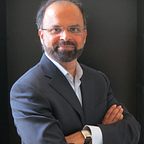Software Defined Control is a Game of Thrones
SDx (software-defined everything) is not about software. It is about shifting of control.
We hear about software eating our increasingly digitized world. Pervasively connected devices and software enables us to shift control at a whim. This shift in power could upstage your businesses if you don’t manage it carefully.
Here are the five ways technology is enabling the shifting of control:
- Ground to Cloud
- Distributed to Centralized
- Cloud to Edge
- Companies to Ecosystems
- Human to Machine
The first four above are progressively complex. The last is the simplest, but most controversial.
Control Shift: Ground to Cloud
Nearly forgotten are our Garmin and Magellan GPSs with their friendly (or annoying) voices directing our movement. We have delegated control to a more intelligent voice from the cloud. Car GPS businesses are out of business.
Axiom: If something can be controlled from the cloud, it will be and it should be.
Control Shift: Distributed to Centralized
In the telecom and networking world, control has been shifting for decades. In the networking and telecom world, they say, “control plane is separated from the data plane”. Once separated, the control can be on the ground or in the cloud. Distributed network decisions got centralized (“software-defined”). Software-defined networking evolution is similar to living organisms evolving to be more intelligent. More on this topic here (SDN and Biology).
If control shift happens to complex telephone networks and the internet, it will happen to your robots business or your land mower business.
Control Shift: Cloud to Edge
In the world of industrial automation, control is shifting. Your drone or robot is getting connected to a central place, likely in the cloud. From the cloud you can orchestrate drones and droids to get work done, like surveillance and security. This is shown below on the left. But there is more…
When the volume of such endpoints grow or you deploy them to mission-critical needs, you will need to shift control to the edges of your business as shown on the right and as described here (Proximity Computing: Edgy, Edgier, Edgiest). This poses threats and opportunities to innovate, not to mention architectural challenges at the network and application layers.
Control-Shift: Company to Ecosystem
This is the Mother of All Control Shifts (MOACS?). It encompasses all the previous scenarios into one macro shift of control. You digitized the human dispatcher. You orchestrated the ecosystem and then you are snipping away at the remaining humans with automation. More on this digital transition here (Uber and the Digitization of Louis De Palma).
Mock this MOACS (Mother of All Control Shifts) at your peril. If you do, you might find yourself dis-intermediated by the digital value chain.
Control-Shift: Human to Machine
This is the most sensitive topic all around this decade due to impact on jobs. It is not the most complex when you view this as a human to machine transfer of control.
Control shifts enabled by technology will result in profound power shifts regardless of industry. How you adapt to it and leverage it in your business will determine your success.
If you don’t, your control over your business will be as transient as someone ruling the seven kingdoms.
